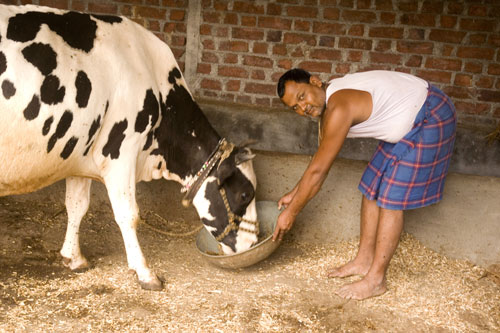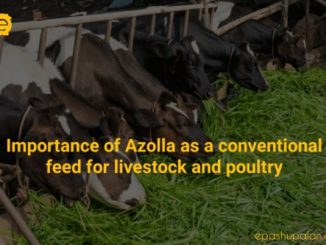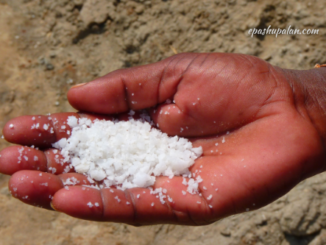Microbial growth and various fermentation processes in the rumen require an adequate supply of minerals.
Principal Functions of the Major Minerals in the Microbial Environment
Major minerals contribute to the regulation of some physicochemical characteristics of the rumen medium such as osmotic pressure, buffering capacity, redox potential and dilution rate, all of which affect rumen fermentations and microbial activity.
Osmotic pressure
Minerals contribute even more than volatile fatty acids (VFA) to rumen osmolarity. Digestion in the rumen can be impaired by high osmotic pressures. Above 400 m.osmol/kg, cellulose degradation and feed intake get decreased; therefore a large addition of major minerals to the diet may depress rumen fermentations by affecting osmolality in the rumen. This factor must not be neglected in studies of the effect of minerals.
Buffering capacity
Under normal feeding conditions, the main buffering components in the rumen are Na and K bicarbonate and VFA, while salivary phosphate helps to neutralize acids produced in the rumen. Thus, imbalance or low level of minerals has impact on microbial activity and ruminal fermentation.
Dilution rate
Dilution rate can possibly be increased by addition of mixed salts similar to those of artificial saliva to the diet resulting in an alteration of the fermentation pattern towards an increase in the molar proportion of acetic and a decrease in that of propionic acid. Nitrogen (N) metabolism in the rumen can also be modified to enhanced N retention in ruminants.
The major minerals play an important part in maintaining the characteristics of the rumen medium, and conditioning the fermentation pattern.
Phosphorus
Functions and content in micro-organisms
Phosphorus (P) is essential to all micro-organisms. It is necessary for carbohydrate fermentation and is a constituent of primary cell metabolites such as the nucIeotides and of coenzymes such as flavin phosphates, pyridoxal phosphate and thiamine pyrophosphate. Most cellular RNA is found in the ribosome, and ribosomal content in bacteria is directly proportional to bacterial growth rate. Thus bacterial growth rate is influenced by P concentration in rumen. It was considered that about 80 % of the total P in rumen bacteria is contained in nudeic acid and about l0 % in phospholipids. P also has positive effect on cellulolytic activity in rurnen fluid.
Effect of high levels of dietary calcium and magnesium
An in vitro study of Ca-P-Mg interactions on cellulose digestion suggested that the P requirements of rumen bacteria increased as the Ca concentration in the medium rose. The same was true for high levels of Mg. An excessive amount of one of these elements relative to the others have a deleterious effect through formation of salts, in particular when the pH is about 7.0. In vitro utilization of P by cellulolytic bacteria get reduced by a high Ca : P ratio in the medium. Addition of Ca in vivo has a depressive effect on soluble inorganic P content in the rumen.
Magnesium and Calcium
Functions and content in micro-organisms
Functions
Mg is involved in preserving the integrity of the cell membrane, and a deficiency often induces morphological changes. Many bacterial enzymes are activated by Mg, including phosphohydrolases and phosphotransferases. The synthesis of nucleic acids is most sensitive to Mg2+ deprivation; therefore, proteosynthesis is disturbed in many bacteria lacking Mg. The Mg requirement for microbial growth is considered as absolute, no other cation can be totally substituted for Mg. However, the Mg requirements of some bacteria can be reduced by the addition of Mn. Ca is involved in the synthesis and stability of cell wall structures. The level of internal Ca has been shown to be minimized by means of a Ca membrane transport system which is probably energy-dependent. All Ca-requiring enzymes are thought to be extracellular and include many microbial hydrolytic enzymes such as proteases, nucleases, lipases, a-amylases, and cellulases. However, internal enzymes can require any of several divalent cations. Mg2+ or Mn 2+ may replace Ca 2+. Micro-organisms require a smaller amount of Ca than Mg.

Potassium and Sodium
Functions and content in micro-organisms
Potassium (K) is universally required by micro-organisms, but it can be replaced by rubidium (Rb) either totally or partially. K is essential for protein synthesis and glycolysis. Most predominant rumen bacteria seems to contain enzymes whose activity requires K+
Sodium (Na) is present in substantial amounts in resting bacteria, but almost absent from bacteria except halophiles.
Trace Elements
Functions and Content in Micro-Organisms
lron
Iron (Fe) is needed for the synthesis of many enzymes during the growth of micro-organisms. It is found mainly in heme, but also in non-he me proteins where its function is electron transfer. Cytochromes (heme proteins) occur in, and are essential to all aerobic bacteria. Cytochromes have been demonstrated both in the heme-dependent and heme-independent strains of the anaerobic rumen bacterium Bacteroides ruminicola where they form an electron transport system for succinate production.
Manganese
Manganese (Mn) is required in trace quantities for the growth of most cells, operating during glycolysis in the decarboxylation reactions of the citric acid cycle. As already mentioned above, Mn2 + can serve as an alternative cofactor to Mg2+ in a large number of enzymes. However, an enzyme may have a specific requirement for Mn in one microbial strain, while in another, Mn can be replaced by Mg2+ or even by other divalent cations such as Zn2+ or Co2+.
Zinc
Zinc (Zn) appears to be essential to all living systems. Its functions in microorganisms were reviewed recently by Failla who gave a comprehensive list of microbial Zn metalloenzymes including intracellular (DNA and RNA polymerase), wall-associated (alkaline phosphatase) and extracellular (amylase and neutral proteases) enzymes. Zn deficiency in micro-organisms therefore results in an upset metabolism. Zn also plays a role in the adherence of celluloyltic rumen bacteria to feed fibre.
Cobalt
Cobalt (Co) is integrated into the structure of vitamin BI2 and, since the functions of the B12 coenzymes are widespread, many bacteria capable of synthesizing cobalamins require Co.
Other trace elements are essential for some microbial functions, such as molybdenum in nitrate reduction and N2 fixation, selenium in seleno-protein enzymes and nickel for urease activity.
Effect of trace element supplementation in vivo
Digestion of carbohydrates
- Mo supplementation has positive effect on fibre digestibility.
- Co and Cu also increase cellulose degradation in the rumen.
- Cu,Co, Mn and Zn addition via using mineral mixture stimulate VFA production.
The mineral supplementations with some trace element also change the molar proportions of VFA. It was generally observed that the molar proportion of propionic acid increased as VFA production was accelerated by trace elements. In vivo, Ni supplementation also increase the proportion of propionic acid.
Selenium (Se) supplementation in a Se-deficient diet in vivo significantly increase the production and molar proportion of isovaleric acid. Whether these modifications are associated with changes in the activity of microbial seleno-enzymes or with changes in protein degradation is not clearly understood.
Nitrogen metabolism
Urease activity
A small amount of some trace elements appear to be essential for urease activity. Ni supplementation (5 mg/kg DM) was shown to stimulate urease activity in-vivo. These findings may have a practical importance in ruminants on low protein diets in which N recycling can be increased by Ni-supplementation.
Protein synthesis
Co as well as Zn increased protein concentration and the total number of micro-organisms, but again the trace element mixture had the most pronounced effect. Rumen bacteria are capable of metabolizing inorganic Se and of incorporating it into microbial protein. When a Se-deficient diet (0.02 mg of Se/kg) was Se-supplemented (0.12mg/kg) it stimulated the incorporation of methionine into the rumen microbial fraction. Therefore, the presence of dietary Se in the rumen was thought to affect profoundly the rate of methionine metabolism in rumen micro-organisms.
Vitamin B12 synthesis
It is well known that the quantity of vitamin B12 synthesized in the rumen depends on the dietary Co level. The distribution of a Co deficient diet (0.01-0.05 mg/kg DM) produced a sharp decline in vitamin B12 production within a few days in the rumen leading to a vitamin BI2 deficiency in the animal. The daily administration of Co into the rumen rapidly restored the vitamin B12 status.
Depressive or inhibitory effects of excessive amounts of trace elements on rumen microbial digestion
Inhibitory effects of trace elements in vitro
- Macro mineral additions can alleviate some of the inhibitory effects of trace elements on cellulolytic activity. Inhibition of growth of baeteria by Co2+ can be prevented by increasing the Mg2+ level in the medium. Mg (25-250 mg/I) partially inhibits the severe depression caused by excess Ni and Co either separately or together.
- Ca (20-40 mg/I) partially protects against the toxic effect of excessive Zn. Addition of S protects against Cu toxicity. Although addition of either S or Mo is ineffective in arresting the inhibition of cellulolysis caused by excessive Cu. The simultaneous presence of the three elements (Cu, S, Mo) in concentrations in which they were not individually harmful, proved toxic to cellulose digestion in many studies. The formation of oxythiomolybdates may inhibit cellulose digestion.
- Different species of rumen bacteria do not show the same sensitivity to trace element toxicity. In general, Streptococcus bovis shows the greatest resistance.
- Furthermore, some studies show that cellulolytic activity is inhibited by lower amounts of trace elements than either fermentation rate or protein synthesis. These differences in response are of course not only due to variations in the medium and flora composition, but also due to a specific toxic effect on cellulases. Since cellulases are extracellular or wall-attached they are more exposed to soluble elements than the intracellular enzymes protected by the cell-wall barrier. Zn was inhibitory to cellulolytic activity at levels which did not affect protein synthesis from urea.
- Excessive amounts of trace elements depress the formation of VFA and may alter the fermentation pattern. Excessive amounts of trace elements decrease the percentage of propionic acid.
- Purified urease is strongly inhibited by low concentrations ( < 2 mg/I) of several trace elements including Cu, Zn, Co and Ni, but when urease is crudely extracted, higher concentrations of these elements are necessary and when total rumen fluid is used, much higher levels are required to depress urease activity.
- Since urease is intracellular, it is well protected against Zn toxicity by the cell wall or membranes. At high Zn levels (180 mg/l) bacterial cells had to be disrupted to show a significant inhibition of urease activity.
- Cu and Se have been shown to be highly toxic to protein synthesis.
- Se toxicity to bacteria is generally recognized as being due to a widespread substitution of Se for S in amino acids which are subsequently incorporated into the cellular proteins.
- Protozoal growth seems to be more sensitive to excessive levels of trace elements than bacterial growth. This is well known in the case of Cu. In early experiments CuSo4 was one of the inhibitors used for defaunation. Zn and Co also decreased protozoal growth in cultures when present in excess.
Effect of excessive amounts of trace minerals in vivo
- In vivo studies of this particular aspect of mineral toxicity are scarce. Distribution of 285 or 570 mg Cu/day to cattle significantly reduced the rumen protein concentration. Cu, one of the most toxic elements in vitro, have depressive effects in vivo on microbial digestion when fed in excess of about 100 mg/kg DM.
- High Zn intake tended to impair rumen metabolism, and total VFA concentrations get decreased after excessive Zn supplementation. In a study, after 6 weeks of the Zn treatment, two sheep out of four were totally defaunated, thus inhibit protozaol growth in rumen. Also, Zn defaunation reduced NH3 concentrations in the rumen. Defaunation in animals fed a urea diet may improve their N status.
- The rumen flora is most likely to be capable of adaptation to elevated levels of other minerals as was noted with Zn. A high adaptive capacity of soil micro-organisms to high soil levels of Co, Se, B, etc has been clearly established . It was seen that trace element uptake was often lessened in adapted organisms.
Possible use of trace elements in the control of ineffective fermentation processes
CuS04 was shown to influence the fermentation pattern of the continuous culture of rumen micro-organisms favorably by decreasing methane and increasing propionic acid formation. This effect however could not be reproduced in vivo studies conducted by Wolin. In vitro results on the inhibitory effects of trace elements on microbial metabolism are difficult to transpose to an in vivo situation because so many factors may affect the responses, e.g. the diet, the rumen medium, rumen solubility of the element and the nature of the micro-organisms.
Conclusion
On the basis of research reported so far; it is often difficult to estimate the amounts of minerals accurately which the diet must supply in order to meet rumen microbial requirements. Indeed, many results were obtained in experiments in vitro in which the animals providing the inoculums were generally fed with conventional diets, without special adaptation to the minerals involved in the study. Because of the ability of bacteria to accumulate many minerals it is often not easy to show clearly the specific requirement for a given element and large variations in the response to mineral additions are observed in fermentation processes. Moreover, in toxicity studies these techniques do not take into account the adaptive capacity of the microflora. Therefore, the data so obtained should only be considered as indicative. However, when as in in-vivo experiments, the inoculum donors are adapted to the study, the results obtained in-vitro might be more valuable.
Furthermore, application of continuous culture techniques in this field of research might result in more accurate information. Growing or lactating animals fitted with re-entrant cannulae in the proximal duodenum should be employed in the future to estimate the influence of minerals on microbial protein synthesis and fibre digestion in the rumen correctly.






Be the first to comment